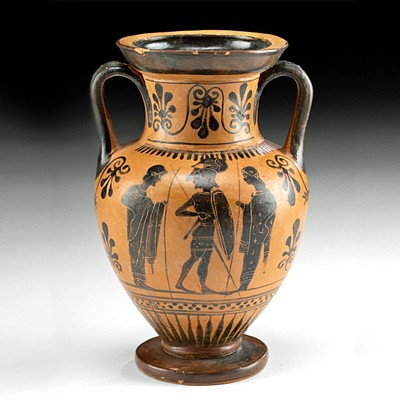Roman Bronze Statuette Nude Male Boxer w/ Cestus
Lot 52
About Seller
Artemis Gallery
686 S Taylor Ave, Ste 106
Louisville, CO 80027
United States
Selling antiquities, ancient and ethnographic art online since 1993, Artemis Gallery specializes in Classical Antiquities (Egyptian, Greek, Roman, Near Eastern), Asian, Pre-Columbian, African / Tribal / Oceanographic art. Our extensive inventory includes pottery, stone, metal, wood, glass and textil...Read more
Estimate:
$1,800 - $2,700
Absentee vs Live bid
Two ways to bid:
- Leave a max absentee bid and the platform will bid on your behalf up to your maximum bid during the live auction.
- Bid live during the auction and your bids will be submitted real-time to the auctioneer.
Bid Increments
| Price | Bid Increment |
|---|---|
| $0 | $25 |
| $300 | $50 |
| $1,000 | $100 |
| $2,000 | $250 |
| $5,000 | $500 |
| $10,000 | $1,000 |
| $20,000 | $2,500 |
| $50,000 | $5,000 |
| $100,000 | $10,000 |
| $200,000 | $20,000 |
About Auction
By Artemis Gallery
Mar 9, 2023
Set Reminder
2023-03-09 10:00:00
2023-03-09 10:00:00
America/New_York
Bidsquare
Bidsquare : Exceptional Ancient, Ethnographic, & Fine Art
https://www.bidsquare.com/auctions/artemis-gallery/exceptional-ancient-ethnographic-fine-art-12354
Artemis Gallery info@artemisgallery.com
Artemis Gallery info@artemisgallery.com
- Lot Description
**Originally Listed At $1500**
Roman, Imperial Period, ca. 1st to 2nd century CE. A rare statuette of a nearly nude boxer shown in stride as though about to deliver a powerful punch as he grasps a spiked caestus or cestus - a metal boxing glove with sharp thongs - in his right hand as the leather straps of his himantes protect his arms. The ancient fighter boasts an athletic build with muscular limbs and a chiseled abdomen above a delineated phallus. Gazing forth from huge, bulging eyes, his beardless visage displays a round nose, full lips, and prominent indentations in his temples and forehead. His incised coiffure is pulled back into a trisected top bun, above sizable ears. Size: 2" W x 3.3" H (5.1 cm x 8.4 cm); 4.3" H (10.9 cm) on included custom stand.
According to History Professor Byron J. Nakamura in "The Cambridge Companion to Boxing": "During the imperial period in the first century ad, Roman boxing stood alongside the gladiator matches and arena beast hunts that emphasized Rome's power and dominance over man and nature. Rome's first emperor, Augustus, was an avid follower of boxing and enjoyed contests between Roman and Greek pugilists. In ad 14 Tiberius, Augustus' successor, introduced in his honor the first set of regularly held celebratory games, in Naples, called the Ludi Augustales.15 In Greece, boxing was still firmly entrenched in the sacred Panhellenic games, but their function had turned from the celebration of the polis itself to the aggrandizement of Roman rulers. Ironically, venues for games increased under Roman emperors who introduced Greek-style events into the city of Rome itself, including the Neronian games and the Emperor Domitian's Capitoline games. (Nakamura, Byron J. "Boxing in the Ancient World." In "The Cambridge Companion to Boxing," edited by Gerald Early, 22-33. Cambridge Companions to Literature. Cambridge: Cambridge University Press, 2019.)
PLEASE NOTE: Due to recent increases of shipments being seized by Australian & German customs (even for items with pre-UNESCO provenance), we will no longer ship most antiquities and ancient Chinese art to Australia & Germany. For categories of items that are acceptable to ship to Australia or Germany, please contact us directly or work with your local customs brokerage firm.
Provenance: East Coast collection, New York Gallery, New York City, New York, USA, acquired before 2010
All items legal to buy/sell under U.S. Statute covering cultural patrimony Code 2600, CHAPTER 14, and are guaranteed to be as described or your money back.
A Certificate of Authenticity will accompany all winning bids.
We ship worldwide and handle all shipping in-house for your convenience.
#137625Missing feet and left forearm. Small chip to chin and some expected nicks and abrasions, commensurate with age. Otherwise, excellent with impressive preservation of detail and lovely green patina.Condition
- Shipping Info
-
All shipping is handled in-house for your convenience. Your invoice from Artemis Gallery will include shipping calculation instructions. If in doubt, please inquire BEFORE bidding for estimated shipping costs for individual items.
-
- Buyer's Premium



 EUR
EUR CAD
CAD AUD
AUD GBP
GBP MXN
MXN HKD
HKD CNY
CNY MYR
MYR SEK
SEK SGD
SGD CHF
CHF THB
THB














